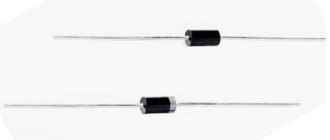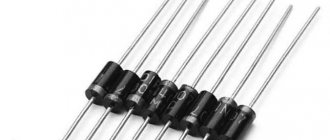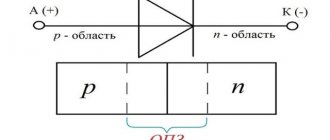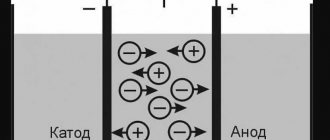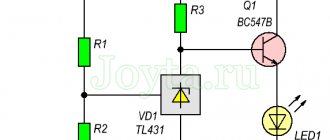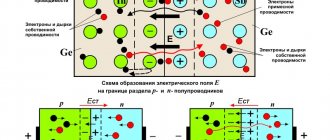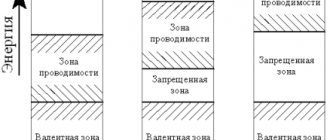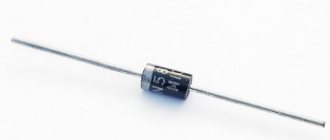Characteristics
- The material of manufacture is silicon.
- Transition. Manufactured using diffuse technology.
- Low forward voltage.
- Large pulse current in the forward direction.
- Soldering. Solders with a melting point of up to 275 °C are used, the operation time is no more than 10 seconds.
- Housing – DO-41 (DO-204AL), smd DO-214AC
- The material of manufacture is epoxy resin.
- Fire resistance of the housing - UL 94 V-0.
- Conclusions. Prepared for soldering and meeting the requirements of international standards J-STD-002 and JESD 22-B10.
- Cathode. Indicated by a colored stripe on the body.
Diode 1N4007 characteristics:
- maximum long-term forward current at 75°C - 1.0 A;
- maximum pulse current with a pulse duration of 3.8 ms - 30 A;
- voltage drop across the diode at a current of 1.0A - 1.1 V;
- operating temperature range - -65…+175°С;
- maximum operating frequency - 1 MHz;
In addition to the reverse voltage, an essential characteristic is the forward current; for the 1N4007 it reaches 1 A. Theoretically, these diodes could be used in a 220 W switching power supply if good heat dissipation from the diodes is ensured (for example, by filling them with compound), but it is not so extreme approach these diodes and in the input rectifier of a 220 V power supply, you should not exceed a power of 50 - 100 W, depending on the efficiency of the cooling system.
General characteristics
| Designation | Parameter | Magnitude |
| IF(AV) | Direct current | 1.0A |
| IFSM | Sinusoidal forward current, T=8.3 ms | 30 A |
| IFSM | Rectangular forward current, T=1 ms | 45 A |
| VF | Forward voltage | 1.1 V |
| IR | Reverse current | 5.0 μA |
| TJ max | Maximum junction temperature | 150 °C |
| Designation | Parameter | 1N4001 | 1N4002 | 1N4003 | 1N4004 | 1N4005 | 1N4006 | 1N4007 | Unit change |
| VRRM | Peak Repetitive Pulse Reverse Voltage | 50 | 100 | 200 | 400 | 600 | 800 | 1000 | V |
| V.R.W.M. | Peak operating reverse voltage | ||||||||
| VDC | Constant blocking voltage | ||||||||
| VRMS | RMS voltage | 35 | 70 | 140 | 280 | 420 | 560 | 700 | V |
| IF(AV) | Average rectified current, TA = 75 °C | 1 | A | ||||||
| IFSM | Direct peak non-periodic overload current | 30 | A | ||||||
| VFM | Forward voltage at IF = 1.0A | 1 | V | ||||||
| IRM | Peak reverse current at TA =25°C | 5 | μA | ||||||
| IRM | Peak reverse current at blocking voltage and TA=100°C | 50 | μA | ||||||
| Cj | Transfer capacitance | 15 | 8 | pF | |||||
| RθJA | Thermal resistance air-to-air junction | 100 | K/W | ||||||
| T.A. | Temperature at maximum blocking voltage | 150 | °C | ||||||
| T.J., T.S.T.G. | Operating and storage temperature range | -65…+150 | °C | ||||||
Appearance
1n4007, as well as all elements of this line, have a molded body made of non-flammable plastic. In order not to think about which side of this element is which, there is a colored stripe on the casing side of the cathode output.
Installation of such diodes is allowed both vertical and horizontal - it doesn’t matter. In general, these elements are very unpretentious, which, combined with their endurance and low cost, of course, makes them truly irreplaceable.
In appearance, they are no different from other diodes, and therefore it is necessary to pay attention to what markings are applied to the body.
It is very important that such diodes are very difficult to overheat when soldering, since it has long contact legs (about 2.5 cm), which, as is known, work as a heatsink. The 1n4007 diode itself can withstand direct heating up to 250 degrees for 10 seconds.
To summarize, we can say with confidence that the diodes of this line, as well as their analogues, are a very convenient solution when assembling circuits for various power devices for both 220 and 380 volts.
The 1N4007 diode is probably the most popular of all diodes, as it is installed in the vast majority of phone chargers, smartphones and tablets. Even if you are holding a charger for a dollar and there is no stabilization or interference filters inside, it cannot do without a diode.
And in one adapter there are four such diodes and a diode bridge is assembled on them; it is used to obtain direct voltage from alternating voltage. The diode allows current to pass through itself in only one direction, cutting off one of the voltage polarities.
Read also: How to glue polyurethane together
By the way, especially cheap chargers use half-wave rectification and save three out of 4 diodes. But if the power of the power supply is more than one Watt, then it is still better to use a diode bridge, since unipolar rectification produces much larger ripples, and this mode is much more difficult for filter capacitors.
The colored ring on the 1N4007 body indicates the cathode terminal.
Since the 1N4007 is produced with leads of sufficient length, the diode can be installed both vertically and horizontally.
The 1N4007 diode is one of the representatives of a whole series of diodes 1N4001, 1N4002, 1N4003, 1N4004, 1N4005, 1N4006, 1N4007. These types of diodes differ in the value of the maximum permissible reverse voltage (the values for each type are given in the table). 1N4007 is designed for the highest voltage.
| 1N4001 | 1N4002 | 1N4003 | 1N4004 | 1N4005 | 1N4006 | 1N4007 | |
| maximum permissible reverse voltage, V | 50 | 100 | 200 | 400 | 600 | 800 | 1000 |
| maximum AC voltage (rms value), V | 35 | 70 | 140 | 280 | 420 | 560 | 700 |
Since the cost of diodes from the entire 1N4001-1N4007 series is very low, and there is practically no difference in cost between types, there is no particular point in using different types in development and increasing the range. You can install 1N4007 everywhere, even if during repairs you need to replace a diode from this series with a lower voltage.
Analogs
Domestic analogues presented in the table are considered for 1N4007:
| Replacement | VR | VF | IF |
| 1N4007 | 1000 | 1 | 1 |
| KD528D | 1000 | 1,5 | |
| KD243Zh | 1000 | 1,1 | 1,5 |
Note: the data in the table for the 1N4007 diode and those suitable for replacement are taken from the manufacturer's datasheet.
Imported manufacturers offer larger rectifier diodes to replace the 1N400X. The most suitable technical parameters are:
- HEPR0056RT (Motorola),
- BYW27-1000 / BY156 (SGS Thomson Microelectronics),
- BYW43 (Siemens AG),
- 10D4 / 1N2070 / 1N3549 (several US manufacturers).
Diode parameters
The 1N4007 diode is a planar silicon diode with parameters standard for medium-power voltage rectifiers operating at frequencies up to 1000 Hz. In some descriptions there may be incorrect designations like in4007. Available in a DO-41 plastic case, with tinned wire axial leads, for through installation into printed circuit board holes (THT). The DO-35 and A-405 versions differ slightly in size. Surface mount (SMD) products are manufactured in DO-214 (SMA) package. Appearance In most cases, the DO-41 case is painted with abrasion-resistant paint with the full name of the diode - 1N400X.
The marking of SMD components, on which it is impossible to place the full name, has several options determined by the device manufacturer: S7, M7, A7 and others. The number here corresponds to the last one in the full designation. The negative terminal (cathode) is always indicated by a white or gray stripe. There are no special installation requirements; soldering of leads for DO-41 is allowed at temperatures up to 260 °C, for no more than 10 seconds, at a distance of 9.5 mm from the housing. Operating and limiting parameters For 1N4007, characteristics are measured at an ambient temperature of 25 ° C, unless otherwise specified.
The 1N4007 diode is one of the representatives of a whole series of diodes 1N4001, 1N4002, 1N4003, 1N4004, 1N4005, 1N4006, 1N4007. These types of diodes differ in the value of the maximum permissible reverse voltage (the values for each type are given in the table). 1N4007 is designed for the highest voltage. Comparative characteristics are presented in the table below:
Table of comparative characteristics of the 1N4007 diode and others
Material on the topic: What is a capacitor
The device is switched on using a half-wave rectifier circuit, frequency – 60 Hz, a resistive or inductive load is used. 1n5819 diode: characteristics Characteristics:
- Peak and constant limit reverse voltage – 1000 V;
- Maximum average (RMS) alternating voltage – 700 V;
- Maximum average rectified current – 1.0 A at 75 °C;
- Peak forward current during one half-cycle – 30 A;
- Voltage drop at current 1 A – 1.0 V;
- Thermal resistance crystal - case - 25 oC/W;
- Typical junction capacitance is 15 pF for a frequency of 1 MHz;
- Operating temperature – from -55 to +155 оС.
It will be interesting➡ Types and design of optocouplers (optocouplers)
Other diodes in this line differ only in the values of permissible reverse voltages; they are indicated by the last digit in the marking - from 50 to 800 volts. Important to consider! The limiting value of the forward current depends on the temperature of the case (1 watt of power causes an increase of 25 ° C); in critical designs it is recommended to provide sufficient heat dissipation; in some cases, board pads can be used. Dependence of current on temperature Application features The characteristics of the 1N4007 diode determine the areas of its use - these are AC voltage rectifiers with a frequency of 50/60 Hz. For a 220 volt network rectifier, 1N4007, 05, 06 are used.
In low-power, low-voltage devices (transformer power supplies), the 1N4001 diode can be used with standard output voltages of 12, 24, 36 volts. They do not work at frequencies above 1 kHz: for example, installing a switching power supply in the output stage will lead to unpredictable consequences, including failure of the entire structure. In4007 rectifier diodes do not have unique properties and can be replaced by any with similar parameters, produced in huge quantities by all manufacturers. Domestic rectifier diodes KD243 are complete analogs, like KD208A, KD212. The only difficulty when replacing with Russian products may arise when determining the type - traditionally, domestic manufacturers mark their products with multi-colored stripes or dots, and the information contained in them can only be deciphered using reference books.
Diode 1n4007.
The 1N4007 diode is probably the most popular of all diodes, as it is installed in the vast majority of phone chargers, smartphones and tablets. Even if you are holding a charger for a dollar and there is no stabilization or interference filters inside, it cannot do without a diode. And in one adapter there are four such diodes and a diode bridge is assembled on them; it is used to obtain direct voltage from alternating voltage. The diode allows current to pass through itself in only one direction, cutting off one of the voltage polarities.
Packaging of diodes.
By the way, especially cheap chargers use half-wave rectification and save three out of 4 diodes. But if the power of the power supply is more than one Watt, then it is still better to use a diode bridge, since unipolar rectification produces much larger ripples, and this mode is much more difficult for filter capacitors.
The colored ring on the 1N4007 body indicates the cathode terminal. Since the 1N4007 is produced with leads of sufficient length, the diode can be installed both vertically and horizontally. The 1N4007 diode is one of the representatives of a whole series of diodes 1N4001, 1N4002, 1N4003, 1N4004, 1N4005, 1N4006, 1N4007. These types of diodes differ in the value of the maximum permissible reverse voltage (the values for each type are given in the table). 1N4007 is designed for the highest voltage.
Since the cost of diodes from the entire 1N4001-1N4007 series is very low, and there is practically no difference in cost between types, there is no particular point in using different types in development and increasing the range. You can install 1N4007 everywhere, even if during repairs you need to replace a diode from this series with a lower voltage.
It will be interesting➡ SMD transistors
Analogs 1N4007
Of course, such a popular diode could not be ignored by global manufacturers of semiconductor devices and released their complete analogues:
- Motorola - HEPR0056RT;
- Philips - BYW43;
- Diotec Semiconductor - 10D4, 1N2070, 1N3549;
- Thomson - BY156, BYW27-1000;
- domestic analogue - KD258D.
Rectifier diodes 1N4001 – 1N4007 Diodes 1N4001, 1N4002, 1N4003, 1N4004, 1N4005, 1N4006, 1N4007 have high throughput and low forward voltage drop. In terms of applicability, diodes 1N4001 - 1N4007 are general purpose diodes that rectify currents in circuits up to 1A with a voltage of 50V - 1000V. Diodes of these series have the ability to accumulate charge up to 20pF and can be temporarily used as varicaps. Diode housing type – DO-41. The body material is non-flammable polymer. Operating frequency – up to 60Hz.
Material on the topic: What is a time relay
The cathode terminal of the diode is indicated by a stripe. The diode outputs are axial, the type of installation is through holes, for soldering. The most common use of diodes is in power supplies for various household appliances. The characteristics of the diodes are shown in the table below. The operation guarantee of the diodes 1N4001 – 1N4007 supplied by our company is 2 years. This is supported by the necessary quality documents. The final price for diodes 1N4001, 1N4002, 1N4003, 1N4004, 1N4005, 1N4006, 1N4007 depends on the quantity, delivery time, manufacturer, country of origin and form of payment.
Diodes 1n4007.

